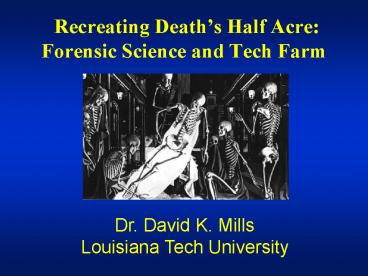Recreating Death - PowerPoint PPT Presentation
Title:
Recreating Death
Description:
Recreating Death s Half Acre: Forensic Science and Tech Farm Dr. David K. Mills Louisiana Tech University Forensic Science at Louisiana Tech University A Brief ... – PowerPoint PPT presentation
Number of Views:57
Avg rating:3.0/5.0
Title: Recreating Death
1
Recreating Deaths Half AcreForensic Science
and Tech Farm
Dr. David K. MillsLouisiana Tech University
2
Forensic Science at Louisiana Tech University
- A Brief History
- Coursework
- Research Activities
- Future Directions
3
Forensic Science
- What is it?
- Components-
- Applied Science
- Basic Science
- Legal/Courts Testimony
- Facilities
4
Scope of Forensic Science
- Criminalistics
- Specialities
- Medicine
- Anthropology
- Odontology
- Entomology
- Others
5
History of Forensic Science
- Chinese medicine-6th Century
- 1839-MJB Orfila, toxicology
- Late 1800s-Alexandre Lacassagne, ballistics and
bloodstain patterns - 1910-Edmund Locard, exchange principle
- 1924-August Vollmer, LAPD crime lab
- 1932-FBI Laboratory, fingerprints
6
Forensic Science is NOT
7
Forensic Science is
- CS Investigators
- Physical Evidence
- Forensic Science
- Forensic Taphonomy
- Forensic Archeology
8
Forensic Anthropology at Louisiana Tech University
- Integrating Field Investigations with Laboratory
Analysis
9
Coursework in Forensic Science
- Forensic Anthropology
- Biological Anthropology
- Research in Forensic Anthropology
- Readings in Forensic Science
- Readings in Bioanthropology
10
Human Osteology Lab
Objectives
- Intense instruction in human osteobiology
- Methods used in human identification
Aging Sexing Population Affinity Diet Pathology Tr
auma
11
Investigative Field Techniques
- Simulated Crime Scenes
- Pics as model corpses
- Forensic Taphonomy
- Forensic Archeology
- Moot Court
12
Crime Scene Excavation
- Site survey and discovery
- Crime scene preservation
- Site formation processes
- Site excavation
- Forensic archeological methods
- Importance of context and the
- chain of evidence
- The art of archeology
13
Recovery and Analysis
- Recovery of material artifacts
- Data recording
- Forensic photography
- Preservation of skeletal remains
- Preliminary field analysis
- Curation and transport
14
Investigative Field TechniquesForensic Archeology
15
Laboratory Analysis and Reconstruction
16
Mock Inquest
17
Mock Inquest
- Each forensic team submits a written forensic
case report. - Students portray expert witnesses and defend
their conclusions. - Afterwards, crime scenario is presented and
compared to forensic team findings.
18
Model Human Corpse
- Hormel pygmy pig is used as a model human
corpse - Document arthropod succession is used to
determine post-mortem death interval - Patterns of decomposition and disarticulation are
documented - The model corpse is used for other research
purposes (e.g. studies in taphonomy)
19
Forensic Entomology
- Students prepare experimental area in environment
A - Two entomology groups sample, monitor and analyze
arthropod and tissue samples
- Model corpse is placed in secured cage surrounded
by dead fall traps - Sampling will begin when first blow fly lands
20
(No Transcript)
21
- Traps are sampled at set times in morning and
afternoon. - Temperature, rainfall and other climatic
variables are measured.
- Arthropods are sorted and counted.
- Arthropod taxonomy is identified, and succession
is determined. - Tissues are fixed and processed for paraffin
embedding and stained. - .
22
Research Activities inForensic Taphonomy
- Bioturbation
- Cut mark analysis
- Differentiating bone trauma from geofact
- Cell and tissue decay
- Site formation processes
- Chlorophyll concentration as PMI indicator
- Hydraulic transport and differential preservation
23
Image Analysis and Forensic Anthropology
24
Bone Modification








![get⚡[PDF]❤ The Trial and Death of Socrates: Four Dialogues (Dover Thrift Editions: PowerPoint PPT Presentation](https://s3.amazonaws.com/images.powershow.com/10043909.th0.jpg?_=20240531065)






















